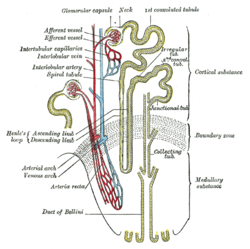| Dent's disease | |
|---|---|
 | |
| Nephron of the kidney without juxtaglomerular apparatus | |
| Specialty | Urology |
| Named after | Charles Enrique Dent |
Dent's disease (or Dent disease) is a rare X-linked recessive inherited condition that affects the proximal renal tubules [1] of the kidney. It is one cause of Fanconi syndrome, and is characterized by tubular proteinuria, excess calcium in the urine, formation of calcium kidney stones, nephrocalcinosis, and chronic kidney failure.
Contents
- Signs and symptoms
- Genetics
- Dent disease 1
- Dent disease 2
- Diagnosis
- Treatment
- History
- References
- External links
"Dent's disease" is often used to describe an entire group of familial disorders, including X-linked recessive nephrolithiasis with kidney failure, X-linked recessive hypophosphatemic rickets, and both Japanese and idiopathic low-molecular-weight proteinuria. [2] About 60% of patients have mutations in the CLCN5 gene (Dent 1), which encodes a kidney-specific chloride/proton antiporter, and 15% of patients have mutations in the OCRL1 gene (Dent 2). [3]

